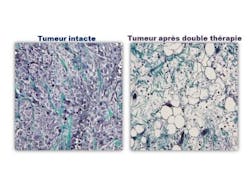Photodynamic therapy, magnetic hyperthermia pair to fight cancer
Scientists at the Laboratoire Matière et Systèmes Complexes (CNRS/Université Paris Diderot) and the Laboratoire Physicochimie des Electrolytes et Nanosystèmes Interfaciaux (CNRS/UPMC) combined magnetic nanoparticles and photosensitizers that are simultaneously and remotely activated by an external magnetic field and light in a liposome to obtain total tumor regression in mice. Non-toxic when they are not activated, such therapies can also achieve a reduction in adverse effects.
Related: Luminescent nanoparticle efficient and effective for PDT, cell imaging
One of the strategies employed to limit the adverse effects of cancer therapies is the development of nanocarrier systems that can convey active ingredients to target tumor cells. These are referred to as "physical" therapies when the active substances, molecules or nanoparticles, can be remotely activated by external light or a magnetic field. In this context, the scientists developed a new type of carrier that combines photosensitivity and magnetism. To achieve this, they first encapsulated magnetic nanoparticles in the inner compartment of a liposome in sufficient quantities to render it ultra-magnetic, before incorporating photosensitizers into its lipid bilayer, while preserving an optimum size for circulation in the blood.
These liposomes, containing magnetic nanoparticles and photosensitizers, were injected directly into the tumor in the mouse model. The scientists thus combined two techniques to achieve complete destruction of cancer cells. The first one, magnetic hyperthermia, consists in exciting the nanoparticles with a magnetic field to raise the temperature of the tumor and destroy it. The second method, photodynamic therapy, is made possible by the photosensitizers, which, when activated, release reactive oxygen species that are toxic to tumor cells. These two physical therapies act in synergy on the activity of the proteins involved in apoptosis, or programmed cell death. Their combination thus induces total regression of the tumor, while a single therapy is not able to stop its growth.
For the research team, the next stage consists in exploiting the "other" magnetic properties of liposomes in order to improve the treatment: nanoparticles are indeed visible under magnetic resonance imaging (MRI) and can be shifted using magnets. After an injection into the bloodstream, it would therefore become possible to use the magnets to target the liposomes towards the tumors, while mapping their final destination by MRI.
Full details of the work appear in the journal ACS Nano; for more information, please visit http://dx.doi.org/10.1021/nn506949t.
-----
Follow us on Twitter, 'like' us on Facebook, connect with us on Google+, and join our group on LinkedIn

